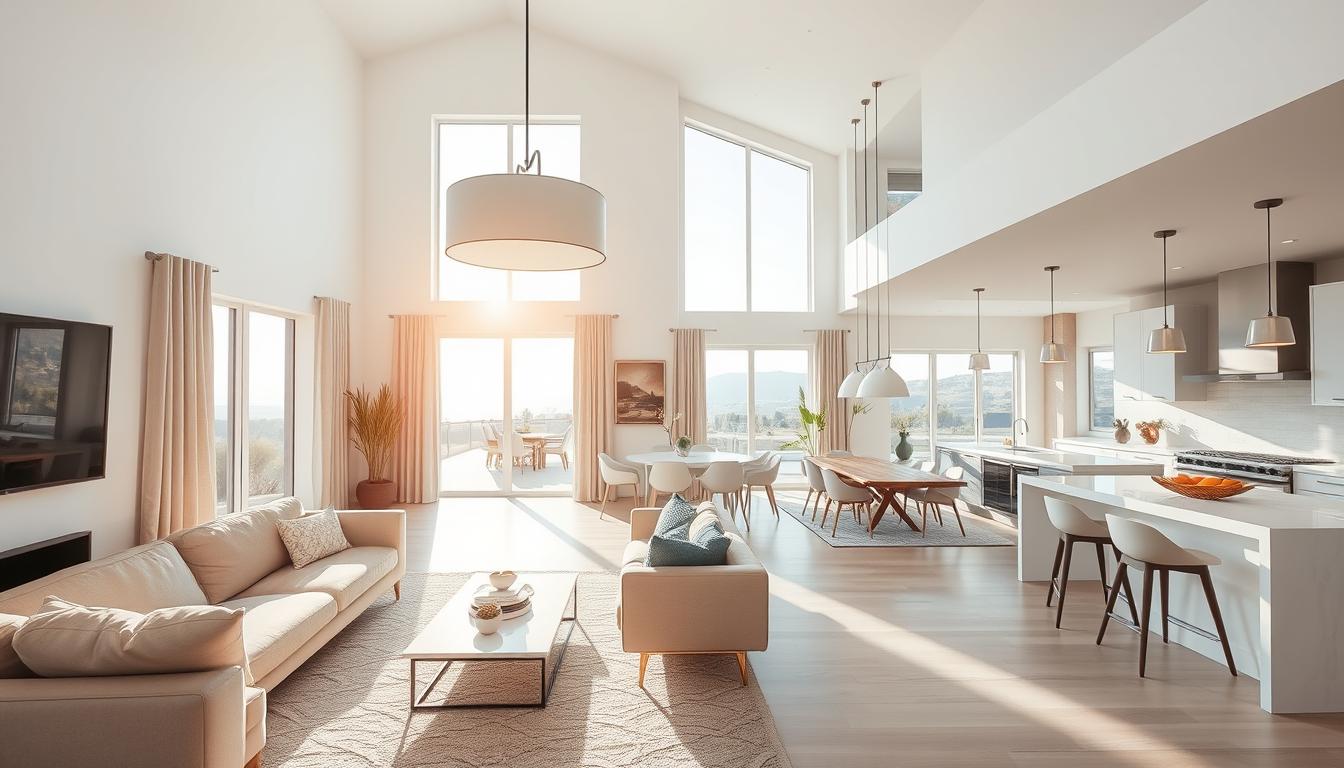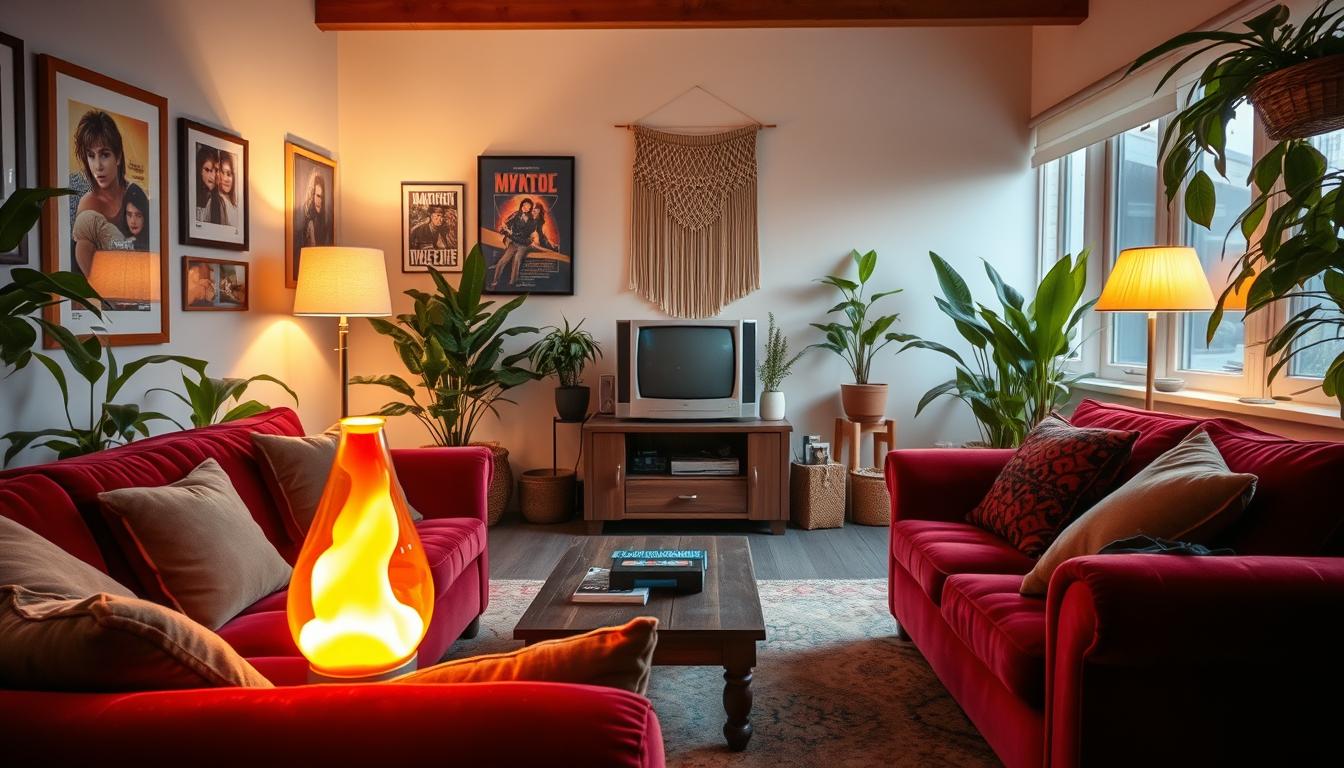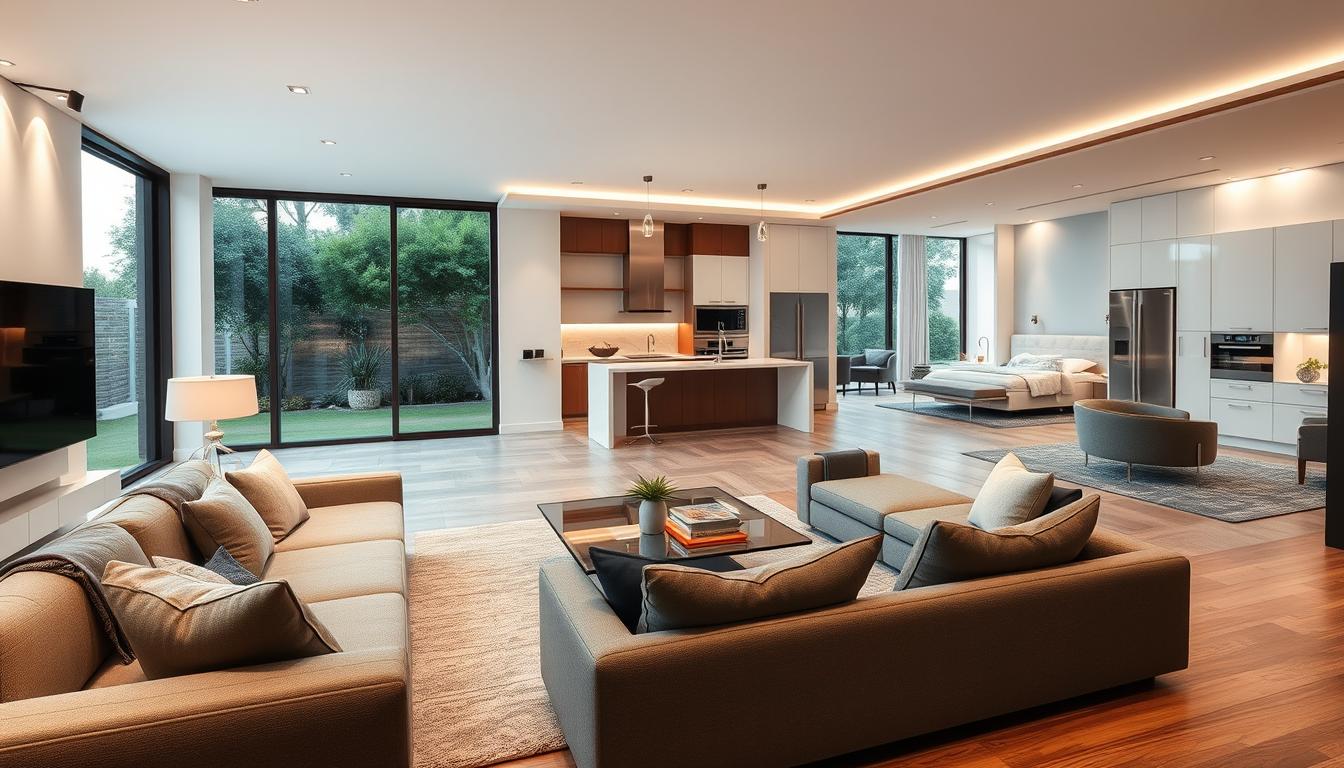Did you know bi-level homes are getting more popular in the U.S.? They mix functionality with style in a unique way. These homes, also known as split-level homes, need careful planning to use space well and let in light.
We’ll dive into the details of modern bi-level homes. We’ll show you how to make an open concept bi-level space that looks great and works well. Our guide will help you understand the basics and make the most of your home.
Key Takeaways
- Understanding the unique challenges of bi-level homes
- Maximizing space and natural light in your home
- Creating an open concept living area
- Tips for designing functional and beautiful interiors
- Ideas for modernizing your bi-level home
Understanding Bi-Level Homes: An Overview
Bi-level homes, also known as split-level homes, have a unique design. They offer both benefits and challenges for designers and homeowners. These homes are popular because they use land efficiently and have a special layout.
These homes have two main living levels connected by a short staircase. This design helps separate living areas, providing privacy and function. It’s important to know the key features of bi-level homes to understand their impact on living spaces.
What Are Bi-Level Homes?
Bi-level homes, or split-level homes, have two main levels. They are often connected by a half-level or a short staircase. This style became popular in the mid-20th century for its affordability and spaciousness.
The design has a main living area on one level and bedrooms and more living spaces on another. This layout makes space distribution functional, meeting the needs of families and individuals.
Key Features of Bi-Level Homes
Bi-level homes have unique floor plans that use multiple levels to save space. The split-level design helps separate living areas. This improves privacy and reduces noise between spaces.
- Multiple living levels connected by short staircases
- Efficient use of land and space
- Separation of living areas for enhanced privacy
- Flexibility in interior design and layout
Knowing these features is key for homeowners and designers. It helps create a cohesive and functional interior design that fits the unique bi-level home style.
Benefits of Bi-Level Homes for Interior Design
Bi-level homes offer creative and functional interior design solutions. They allow homeowners to make the most of their space.
Enhanced Natural Light
Bi-level homes can get a lot of enhanced natural light. With the right window placement, they can feel bright and open.
Windows and skylights can light up the inside. This reduces the need for artificial lights and blends indoor and outdoor spaces.
Flexible Living Spaces
Bi-level homes have flexible living spaces. They can be set up to meet different needs. This makes them great for various lifestyles.
This flexibility is key in functional bi level home layout designs. It helps create a balanced and efficient living area.
Efficient Use of Square Footage
Bi-level homes use square footage efficiently. They split living areas into two levels. This provides plenty of space without needing a big footprint.
This is a big plus for homeowners. It lets them have more space without a huge house.
Choosing a Color Palette for Bi-Level Homes
A good color palette is key for a smooth flow in bi-level homes. The right colors can make each level feel connected and in harmony.
When picking colors, think about the style and mood you want. Modern bi-level homes often look great with neutral tones, bold colors, and lots of natural light.
Popular Color Schemes
There are several color schemes that work well for bi-level homes. These include:
- Monochromatic Neutrals: Shades of white, beige, and gray create a modern, flowing look.
- Bold Accent Walls: A bold color on one wall adds interest and focus.
- Soft Pastels: These colors bring warmth and coziness to your home.
Here’s a look at some popular color schemes for bi-level homes:
| Color Scheme | Description | Best For |
|---|---|---|
| Monochromatic Neutrals | Variations of a single neutral color | Modern, minimalist designs |
| Bold Accent Walls | Neutral background with bold accent walls | Adding visual interest, creating focal points |
| Soft Pastels | Soft, pastel colors for a warm atmosphere | Cozy, inviting interiors |
Tips for Harmonizing Colors Across Levels
To make your bi-level home look cohesive, follow these tips:
- Choose a Unifying Color: Pick a color that ties the home together, as an accent or main color.
- Consider the Flow: Think about how colors move from one level to the next. You can have a gradual change or keep the same colors.
- Use Color to Define Spaces: Use different colors to separate areas or rooms in open-plan spaces.
By choosing a color palette carefully and thinking about how colors work together, you can make your bi-level home beautiful and harmonious. It will show off its unique features well.
Flooring Options for Bi-Level Homes
Flooring in bi-level homes is more than just covering the floor. It’s about making a space inviting and cohesive. The right flooring can greatly change how a home looks and feels.
When picking flooring for a bi-level home, think about style and durability. Different areas of the home might need different flooring. This depends on how much use they get.
Best Flooring Materials
The flooring material you choose can really impact your home’s feel and upkeep. Here are some top picks:
- Hardwood Flooring: Adds warmth and elegance. It’s durable and can be refinished many times.
- Laminate Flooring: A budget-friendly option that looks like hardwood but needs less care.
- Tile Flooring: Great for busy areas and places with moisture, like kitchens and bathrooms. It’s easy to keep clean.
- Carpet: Comfortable and quiet, perfect for bedrooms and living rooms.
| Flooring Material | Durability | Maintenance | Cost |
|---|---|---|---|
| Hardwood | High | Medium | High |
| Laminate | Medium | Low | Medium |
| Tile | High | Low | Medium to High |
| Carpet | Low to Medium | High | Low to Medium |
Transitioning Between Levels
Switching between flooring types or levels needs careful planning. Here are some tips:
- Use transition strips to connect different flooring materials.
- Keep the flooring direction consistent for a smooth flow.
- Make sure the flooring heights match for a smooth transition.
Choosing the right flooring and planning transitions can make your bi-level home more beautiful and functional. Whether you’re updating your kitchen or redoing your living area, these flooring options can help create a unified and attractive space.
Maximizing Space in Bi-Level Homes
Creating a functional bi-level home layout is key for a cozy living space. Bi-level homes, with their split-level design, present both challenges and chances for smart space use. Homeowners need to find new ways to make the most of these homes.
One top strategy is to use creative storage solutions. Bi-level homes have spots perfect for storage, like under-stair areas or built-in shelves. Using these spots well can cut down on clutter and make the home feel bigger.
Creative Storage Solutions
Here are some ideas for better storage:
- Under-stair storage for things like linens, cleaning stuff, or other household items.
- Built-in shelves and cabinets that match the home’s look.
- Secret spots in furniture or decorations.
These storage ideas help keep your home neat and make it feel more open.
Multi-Functional Furniture
Choosing multi-functional furniture is another smart way to use space in bi-level homes. Items like sofa beds, storage ottomans, and desks with storage can do more than one thing. This means you need less furniture, saving space.
For bi-level renovation inspiration, pick furniture that looks good and works well. For example, a storage coffee table can hold things like remotes, books, and more. This keeps your living room tidy.
By mixing creative storage with multi-functional furniture, you can make your bi-level home more efficient, cozy, and roomy.
Optimizing Living Areas in Bi-Level Homes
Bi-level homes offer a great chance to make living areas both open and cozy. By designing these spaces well, homeowners can find a balance between big areas and small, quiet spots.
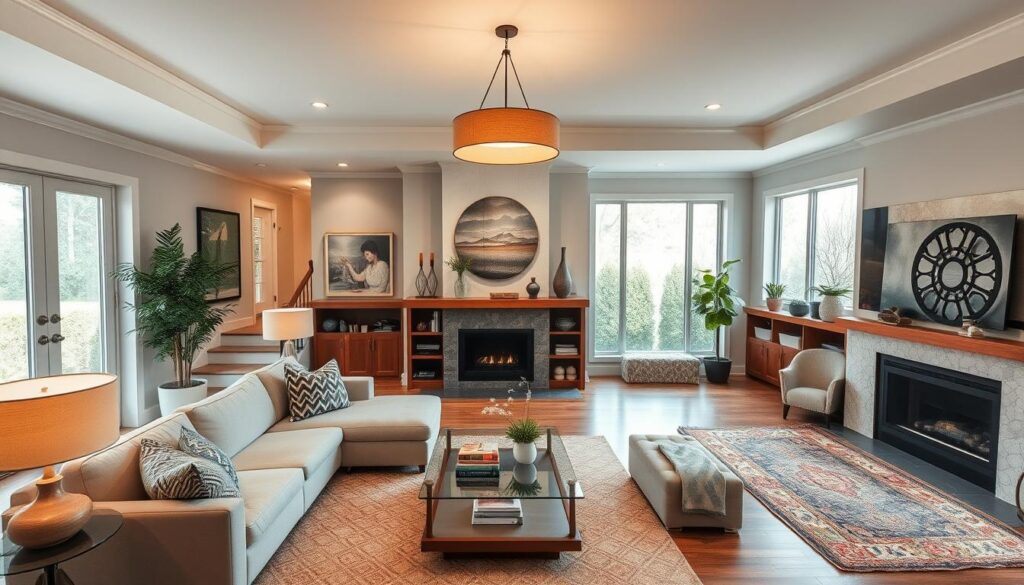
Designing the Main Living Space
Creating the main living area in a bi-level home is key. It should be both useful and look good. An open concept bi level design works well, as it connects different parts of the home smoothly.
- Use a neutral color scheme to keep things flowing.
- Choose furniture that does more than one thing to save space.
- Vertical elements like tall curtains or shelves can make the room feel taller.
Creating Intimate Gathering Areas
Bi-level homes also let you make special spots for gathering. These areas are great for unwinding or having a quiet chat.
- Find a cozy spot to turn into a reading area or a small chat spot.
- Use comfy chairs and soft lights to make it warm and inviting.
- Adding plants or a small water feature can make it even cozier.
By designing both big and small areas well, homeowners can make their bi-level home beautiful and useful. It’s a space that looks good and feels great.
Kitchen Design Tips for Bi-Level Homes
Bi-level homes present unique challenges and opportunities for kitchen design. It’s important to think about both function and beauty.
The kitchen is key in any home, and in bi-level homes, it’s crucial to use space well. Choose the right layout and modern appliances for a functional and stylish kitchen.
Layout Options for Efficiency
An efficient kitchen layout is vital in bi-level homes. Popular layouts include the L-shape, U-shape, and galley configurations. Each offers benefits in workflow and space use.
- L-shape layouts are great for smaller kitchens, offering plenty of counter space and a clear workflow.
- U-shape layouts have lots of counter space and are good for bigger kitchens, allowing for multiple cooks.
- Galley layouts are perfect for narrow kitchens, making the most of space and streamlining workflow.
| Layout | Ideal Kitchen Size | Key Benefits |
|---|---|---|
| L-shape | Small to Medium | Efficient workflow, ample counter space |
| U-shape | Medium to Large | Extensive counter space, suitable for multiple cooks |
| Galley | Narrow | Optimized space use, streamlined workflow |
Incorporating Modern Appliances
Modern appliances are not just about function; they also add to the kitchen’s look. Choose appliances that are both high-performing and stylish.
Some popular modern appliance options include:
- Smart Refrigerators with advanced features like internal cameras and touch screens.
- Induction Cooktops for efficient and safe cooking.
- Energy-Efficient Dishwashers that save water and energy.
By choosing the right layout and modern appliances, homeowners can create a kitchen that’s both functional and stylish. It will be perfect for their bi-level home.
Designing Bedrooms in Bi-Level Homes
Designing bedrooms in bi-level homes is all about creating peaceful and private spaces. It’s important to use the space wisely to make each room a cozy retreat.
Layout Considerations
When planning bedroom layouts, think about natural light, privacy, and the room’s flow. Bedrooms on upper levels can get more light from skylights or larger windows. Lower level bedrooms might need creative lighting.
Good bedroom layouts also make the space more useful. Use multi-functional furniture like storage beds or desks with shelves.
| Layout Feature | Upper Level Bedrooms | Lower Level Bedrooms |
|---|---|---|
| Natural Light | Skylights or larger windows | Creative lighting solutions |
| Furniture | Multi-functional pieces | Space-saving designs |
Adding Personal Touches
Adding personal touches makes bedrooms unique. Hang personal artwork or display family heirlooms to warm up the space.
Textiles like throw blankets, rugs, and bedding also add personality. Pick materials and patterns that show off your style.
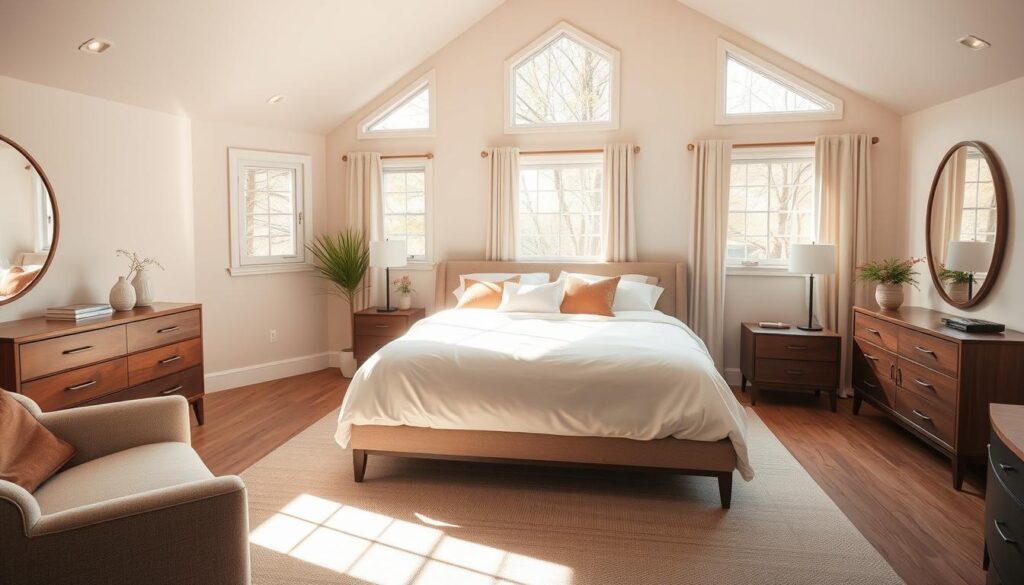
With the right layout and personal touches, bedrooms in bi-level homes can be both stylish and practical.
Utilizing Natural Light in Bi-Level Homes
Using natural light can really change how a bi-level home feels. Homeowners can make their homes look better and work better by planning light use well.
Window Placement Considerations
Where you put windows is key to getting more natural light in bi-level homes. Properly positioned windows can light up dark spots and cut down on the need for artificial light. When you’re designing or redoing a bi-level, think about the house’s direction and where to put windows for the best light.
Big windows on the lower level can let in lots of light. Clerestory windows on the top can light up areas that are usually dark. It’s a good idea to talk to a pro to figure out the best window spots for your home.
For more tips on making your split-level home look great, visit Homestylista.
Choosing Appropriate Window Treatments
It’s important to control light, too. Window treatments help decide how much light gets in and affect the mood. You want to pick treatments that let in light but also keep things private and comfy.
- Sheer curtains or blinds can filter light while still letting you see outside.
- For places like bedrooms, use blackout curtains or shades for more privacy.
- Using different window treatments together can give you more control over light.
Choosing the right window treatments lets you enjoy natural light while also making your home more functional and pretty.
Outdoor Spaces for Bi-Level Homes
The outdoor areas of a bi-level home are key to its charm. They offer spots for both relaxation and fun. It’s important to design these spaces to match the home’s look and function.
Creating Functional Outdoor Areas
To make the most of outdoor spaces in bi-level homes, we should focus on creating useful areas. This includes:
- Patio or deck areas for dining and relaxation
- Gardens or green spaces for recreation or gardening
- Outdoor kitchens or barbecue areas for entertainment
Designing these areas needs careful thought about the home’s layout and how indoor and outdoor spaces connect. For example, an outdoor kitchen is great for cooking and hosting guests outside. It’s important to plan the layout, including seating and cooking spots.
Landscaping Ideas to Complement Design
Landscaping is crucial for a bi-level home’s curb appeal and value. Here are some ideas:
- Use native plants that are easy to care for and good for the local environment.
- Outdoor lighting can highlight the home’s features and create a nice evening atmosphere.
- Try a tiered landscaping design to fit the home’s multi-level layout.
Good landscaping can greatly improve a bi-level home’s look by linking indoor and outdoor spaces smoothly. A well-designed landscape not only makes the home look better but also adds more outdoor living areas to enjoy all year.
| Landscaping Element | Benefits | Considerations |
|---|---|---|
| Native Plants | Low maintenance, supports local biodiversity | Choose plants suitable for your climate and soil type |
| Outdoor Lighting | Enhances safety, highlights architectural features | Consider energy-efficient options and layer lighting for effect |
| Tiered Landscaping | Accommodates multi-level homes, adds visual interest | Requires careful planning to ensure stability and drainage |
Conclusion: Bringing it All Together
Designing a bi-level home’s interior needs careful thought. We’ve seen how bi-level homes can be both creative and practical. This guide has shown us the way.
Designing Your Bi-Level Home
When designing a bi-level home, light and space are key. The right colors, floors, and furniture make a space work well and look good. It’s all about creating a space that feels right for you.
Renovation Inspiration
If you’re renovating your bi-level home, we hope this guide has sparked ideas. You can update your kitchen or make cozy spots for friends and family. The choices are many.
Now, it’s time to try out new design ideas. Use your bi-level home’s special features to make it your own.

